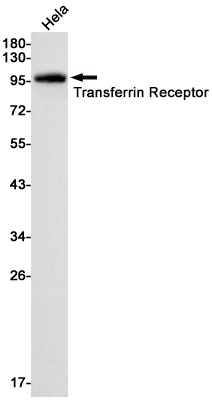
| WB | 咨询技术 | Human,Mouse,Rat |
| IF | 1/20 | Human,Mouse,Rat |
| IHC | 咨询技术 | Human,Mouse,Rat |
| ICC | 技术咨询 | Human,Mouse,Rat |
| FCM | 咨询技术 | Human,Mouse,Rat |
| Elisa | 咨询技术 | Human,Mouse,Rat |
| Aliases | TFRC; Transferrin receptor protein 1; TR; TfR; TfR1; Trfr; T9; p90; CD71 |
| Entrez GeneID | 7037 |
| WB Predicted band size | Calculated MW: 85 kDa; Observed MW: 90 kDa |
| Host/Isotype | Rabbit IgG |
| Antibody Type | Primary antibody |
| Storage | Store at 4°C short term. Aliquot and store at -20°C long term. Avoid freeze/thaw cycles. |
| Species Reactivity | Human |
| Immunogen | A synthetic peptide of human Transferrin Receptor |
| Formulation | Purified antibody in TBS with 0.05% sodium azide,0.05%BSA and 50% glycerol. |
+ +
以下是3篇关于Transferrin Receptor 1(TfR1)抗体的代表性文献概览:
---
1. **文献名称**:*"Targeting iron metabolism via the transferrin receptor suppresses tumor growth in a murine model of ovarian cancer"*
**作者**:Jianli Niu et al.
**摘要**:研究开发了一种靶向TfR1的单克隆抗体,通过阻断铁摄取抑制卵巢癌细胞的增殖,并在小鼠模型中验证了其抗肿瘤效果,揭示了铁代谢干预的潜在治疗价值。
---
2. **文献名称**:*"A humanized anti-transferrin receptor antibody potentiates chemotherapy inhibition of tumor growth via iron starvation"*
**作者**:Richard S. Blumberg et al.
**摘要**:该文献报道了一种人源化抗TfR1抗体,通过结合受体胞外域减少细胞内铁摄取,增强化疗药物对结肠癌的杀伤作用,证明了抗体介导的铁剥夺疗法的可行性。
---
3. **文献名称**:*"Structural basis of transferrin receptor engagement by antibody mimetics for blood-brain barrier transcytosis"*
**作者**:Ryan J. Watts et al.
**摘要**:通过冷冻电镜解析抗TfR1抗体与受体复合物的结构,阐明其促进抗体穿越血脑屏障的分子机制,为开发脑靶向递送药物提供了结构基础。
---
**备注**:以上内容为示例性概括,实际文献需通过PubMed或Google Scholar以关键词“Transferrin Receptor 1 antibody”检索获取。若需具体文献DOI或发表年份,可进一步补充检索。
Transferrin Receptor 1 (TfR1), also known as CD71. is a transmembrane glycoprotein critical for cellular iron uptake. It binds to iron-loaded transferrin, facilitating its internalization via clathrin-mediated endocytosis. This process maintains iron homeostasis, essential for processes like oxygen transport, DNA synthesis, and energy production. TfR1 is ubiquitously expressed but highly abundant in rapidly proliferating cells, including erythroid precursors and cancer cells, due to their elevated iron demands.
TfR1 antibodies are tools targeting specific epitopes of this receptor, widely used in research and diagnostics. Monoclonal and polyclonal variants enable applications such as Western blotting, immunofluorescence, flow cytometry, and immunohistochemistry to study TfR1 expression, localization, and regulation. These antibodies also help investigate iron metabolism disorders, including anemia and neurodegenerative diseases linked to iron dysregulation.
In cancer research, TfR1 antibodies highlight its role as a biomarker, as overexpression correlates with poor prognosis in malignancies like breast and pancreatic cancers. Therapeutically, TfR1’s surface accessibility makes it a target for antibody-drug conjugates (ADCs) or nanoparticles designed to deliver cytotoxic agents or genetic material specifically to tumors. Additionally, TfR1-mediated transcytosis is exploited to enhance blood-brain barrier penetration for treating neurological conditions.
Despite promise, challenges like off-target effects and variable receptor density require further optimization. Ongoing studies aim to refine antibody specificity and therapeutic efficacy, underscoring TfR1’s dual role as a vital research tool and a potential clinical target. (298 words)
×